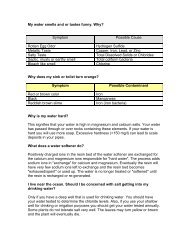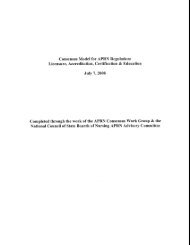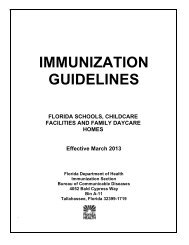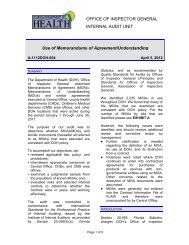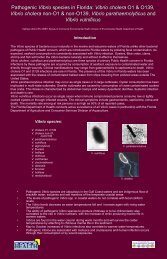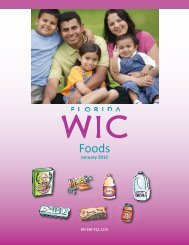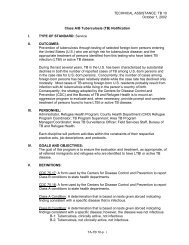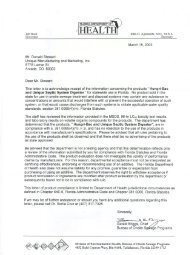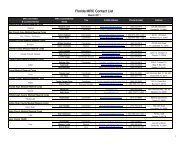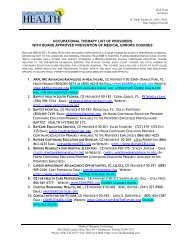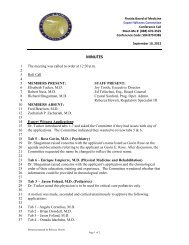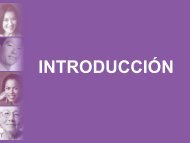Lesson 10 - Healthy Smiles - Florida Department of Health
Lesson 10 - Healthy Smiles - Florida Department of Health
Lesson 10 - Healthy Smiles - Florida Department of Health
Create successful ePaper yourself
Turn your PDF publications into a flip-book with our unique Google optimized e-Paper software.
MATERIALS NEEDED<br />
nDairy Foods (included)<br />
n<strong><strong>Health</strong>y</strong> Foods with Happy Tooth<br />
(included)<br />
nUnhealthy Foods with Sad Tooth<br />
(included)<br />
nBrush Your Teeth Please, by Leslie<br />
McGuire<br />
nChild-size s<strong>of</strong>t bristle<br />
toothbrushes (1 for each child<br />
and teacher—see references for<br />
suggestions on obtaining<br />
toothbrushes)<br />
nPlastic sandwich bag (1 for each<br />
child)<br />
nPermanent marker for teacher<br />
nTeeth template (included)<br />
nNon-toxic glue stick or tape for<br />
teacher<br />
n8½" x 11" piece <strong>of</strong> cardboard or<br />
heavy stock paper (1 for each pair<br />
<strong>of</strong> children)<br />
n6–8 inch piece <strong>of</strong> yarn (1 for each<br />
child)<br />
for children ages 3–4½<br />
concept<br />
Introduce children to the benefits <strong>of</strong> keeping their teeth healthy through smart food<br />
choices, proper brushing, and flossing.<br />
<strong><strong>Health</strong>y</strong> <strong>Smiles</strong><br />
goals<br />
1. Children understand the importance <strong>of</strong> taking care <strong>of</strong> their teeth through<br />
proper dental hygiene and healthy eating.<br />
2. Children demonstrate the correct way to brush and floss their teeth.<br />
3. Children recognize foods that are good for their teeth and foods that are<br />
bad for their teeth.<br />
objectives<br />
1. Children relate the importance <strong>of</strong> why they have teeth.<br />
2. Children express what foods help keep their teeth healthy.<br />
3. Children demonstrate how to brush and floss their teeth.<br />
activities<br />
1Ask the children questions to get them thinking about their teeth. You<br />
can say, “Why do you think we have teeth? Raise your hand if you know<br />
the answer.”<br />
Allow the children an opportunity to respond. Praise them if they respond<br />
with answers like eating, chewing, talking, and smiling. Then say, “Yes, we<br />
need our teeth to eat. Our teeth chop the food in our mouth into smaller<br />
pieces so we can swallow it.”<br />
Ask, “Do you think we really need teeth to talk?”<br />
Wait to see if children understand or respond to why teeth are needed for<br />
talking. Ask the children, “Can you say, 33 thumbs?”<br />
Wait until all <strong>of</strong> the children have had an opportunity to say 33 thumbs.<br />
Then ask, “Did you feel how your tongue pressed on the back <strong>of</strong> your teeth?<br />
How many <strong>of</strong> you used your teeth to make the ‘th’ sound? Teeth help us say<br />
certain words better. Try saying it again and feel how your teeth help your<br />
tongue say 33 thumbs!”<br />
Say, “We know we need teeth to eat and to talk, so how can we make sure<br />
we keep our teeth healthy?”>>><br />
133<br />
HEALTHY SMILES
HEALTHY SMILES<br />
134<br />
>>>Allow time for the children to respond. Then say,<br />
“Some foods can help make our teeth strong. Raise your<br />
hand if you know what type <strong>of</strong> food can make our teeth<br />
strong?”<br />
Wait for a response and then hold up the Dairy Foods<br />
handout (included) that includes illustrations <strong>of</strong> milk,<br />
cheese, and yogurt. Point to the milk first and say, “Milk<br />
makes our teeth strong!”<br />
Continue by pointing to the other items on the handout<br />
and say, “Yogurt and cheese also help make our teeth<br />
strong.”<br />
for children ages3–4½<br />
<strong><strong>Health</strong>y</strong> <strong>Smiles</strong><br />
2Say, “Did you know that some foods can help clean<br />
our teeth too? Raise your hand if you know <strong>of</strong> foods<br />
that can help clean our teeth?”<br />
Allow time for the children to respond. Hold up the<br />
<strong><strong>Health</strong>y</strong> Foods handout (included) and say, “Foods like<br />
apples, carrots, cucumbers, and other crunchy fruits and<br />
vegetables can help clean our teeth.”<br />
Flip the handout over to the Happy Tooth and ask “How<br />
many <strong>of</strong> you want happy teeth?”<br />
Allow time for the children to respond. Say, “When we<br />
eat some <strong>of</strong> these crunchy fruits and vegetables we are<br />
helping to clean our teeth.”<br />
Continue by holding up the Unhealthy Foods handout<br />
(included) and say, “These foods are not good for our<br />
teeth and can cause us to have cavities. Do any <strong>of</strong> you<br />
know what a cavity is?”<br />
Allow the children time to answer or guess. “A cavity is a<br />
small hole in a tooth. It doesn’t go all the way through<br />
but is kind <strong>of</strong> like a tiny cave.”<br />
Flip over the Unhealthy Foods handout to show the Sad<br />
Tooth and say, “When we eat these unhealthy foods we<br />
make our teeth sad. We want happy healthy teeth!”<br />
While saying this, show them the Happy Tooth on the<br />
back <strong>of</strong> the <strong><strong>Health</strong>y</strong> Foods handout.<br />
3Next ask, “How many <strong>of</strong> you brush your teeth?”<br />
Encourage their responses by saying “good job” and<br />
“that’s great.” You can ask, “Why do we brush our<br />
teeth?”<br />
Allow enough time for the children to answer and then<br />
say, “We brush our teeth every day to keep them clean.<br />
When we eat, germs and very small pieces <strong>of</strong> food stay<br />
on our teeth. When we brush we keep our teeth clean<br />
and healthy!”<br />
4In an animated voice read the book Brush Your<br />
Teeth Please. Encourage the children to follow along<br />
by demonstrating what the characters <strong>of</strong> the book are<br />
doing. Ask the children what kinds <strong>of</strong> animals have teeth<br />
and what kinds don’t.<br />
5Provide each child a s<strong>of</strong>t-bristle toothbrush to go<br />
over the correct way to brush their teeth. Say, “Be<br />
sure to brush every tooth. Make sure to brush the top<br />
teeth downwards and bottom teeth upwards. Watch<br />
me!”<br />
Demonstrate brushing your teeth. Then say, “Remember<br />
to brush the front, back, inside, and outside <strong>of</strong> your<br />
teeth!”<br />
Encourage the children to brush gently so they don’t<br />
hurt their gums (explain where their gums are if they<br />
don’t know). After going over how to correctly brush, you<br />
can hand out plastic sandwich bags for each child to<br />
store their toothbrush in (use a permanent marker to<br />
write the children’s names on the bags).
6Prior to the flossing activity, cut out the teeth from<br />
the Teeth template provided and glue or tape the<br />
teeth onto pieces <strong>of</strong> cardboard. If cardboard is<br />
unavailable, then a heavy-stock paper can be used. Pair<br />
the children up so that everyone has a partner.<br />
Create enough teeth so that each pair <strong>of</strong> children can<br />
have one set. Then provide each pair <strong>of</strong> children with a<br />
6–8 inch piece <strong>of</strong> yarn. Ask for a volunteer from the class<br />
to help you clean your set <strong>of</strong> teeth. The volunteer will<br />
hold up the teeth while you demonstrate cleaning to the<br />
rest <strong>of</strong> the children. While “flossing” with the yarn, say,<br />
“Gently floss in between each tooth.”<br />
Ask each child to practice flossing on the teeth held by<br />
their partner. After the first half <strong>of</strong> the children have<br />
practiced flossing, have them switch with their partner<br />
so that the other children can practice as well. Then<br />
explain, “The toothbrush doesn’t always get all the food<br />
and germs from in between our teeth. Flossing helps us<br />
clean food and germs from in between our teeth.”<br />
for children ages3–4½<br />
<strong><strong>Health</strong>y</strong> <strong>Smiles</strong><br />
7After the flossing activity, ask the children to stand<br />
up. Say, “Let’s pretend we are the bristles on top <strong>of</strong> a<br />
toothbrush. Let’s brush the top <strong>of</strong> our teeth by moving<br />
forward.”<br />
Take a step forward and instruct the children to follow.<br />
Then say, “Now let’s brush the bottom <strong>of</strong> our teeth by<br />
moving backwards. Now let’s all move front and back.<br />
Can everyone sway their arms above their heads? Let’s<br />
sway our arms back and forth! This is how our<br />
toothbrush moves in our mouths when we brush our<br />
teeth.”<br />
Instruct the children to continue moving while singing<br />
“Brush Your Teeth” to the tune <strong>of</strong> “Jingle Bells.”<br />
“Brush your teeth,<br />
Brush your teeth,<br />
Give your teeth a treat.<br />
Brush up and down and all around,<br />
To keep them clean and neat!<br />
Brush them once,<br />
Brush them twice,<br />
Brush three times a day.<br />
Brush up and down and all around,<br />
Keep cavities away!”<br />
Say, “I think you all have beautiful and healthy smiles!<br />
We all know how important it is to eat healthy foods,<br />
brush, and floss our teeth every day!”<br />
Remember to make copies <strong>of</strong> the parent letter with the<br />
take-home activity sheet printed on the reverse side to<br />
send home with each child. The community fact sheet is<br />
also included for you to copy and display at your center<br />
or distribute as appropriate.<br />
135<br />
HEALTHY SMILES
HEALTHY SMILES<br />
136<br />
MATERIALS NEEDED<br />
n<strong><strong>Health</strong>y</strong> Foods with Happy Tooth<br />
(included)<br />
nUnhealthy Foods with Sad Tooth<br />
(included)<br />
nDoes a Lion Brush? by Fred<br />
Ehrlich<br />
n<strong><strong>Health</strong>y</strong> <strong>Smiles</strong> handout (included)<br />
nPrimary Tooth Development<br />
diagram (included)<br />
nChild-size s<strong>of</strong>t bristle<br />
toothbrushes (1 for each child<br />
and teacher—see references for<br />
suggestions on obtaining<br />
toothbrushes)<br />
nPlastic sandwich bag (1 for each<br />
child)<br />
nPermanent marker for teacher<br />
nTeeth template (included)<br />
nNon-toxic glue stick or tape for<br />
teacher<br />
n8½" x 11" piece <strong>of</strong> cardboard or<br />
heavy stock paper (1 for each pair<br />
<strong>of</strong> children)<br />
n6–8 inch piece <strong>of</strong> yarn (1 for each<br />
child)<br />
for children ages 4½–5<br />
concept<br />
Introduce children to the benefits <strong>of</strong> keeping their teeth healthy through<br />
smart food choices, proper brushing, and flossing.<br />
<strong><strong>Health</strong>y</strong> <strong>Smiles</strong><br />
goals<br />
1. Children understand the importance <strong>of</strong> taking care <strong>of</strong> their teeth through<br />
proper dental hygiene and healthy eating.<br />
2. Children demonstrate the correct way to brush and floss their teeth.<br />
3. Children recognize foods that are good for their teeth and foods that are<br />
bad for their teeth.<br />
objectives<br />
1. Children indicate the importance <strong>of</strong> brushing and flossing their teeth.<br />
2. Children recognize what foods help to keep their teeth healthy<br />
and strong.<br />
3. Children demonstrate how to properly brush and floss their teeth.<br />
activities<br />
1Say, “Today we are going to talk about a very important part <strong>of</strong> our<br />
bodies—our teeth. Teeth help us do many things.”<br />
Ask the children questions to get them thinking about their teeth, such as,<br />
“Who can name something that we do with our teeth?”<br />
Discuss the childrens’ answers which may include eating, chewing, talking<br />
and smiling. Have the children demonstrate each <strong>of</strong> the actions. For<br />
example, how do our teeth help us eat? Encourage and reinforce their<br />
responses by saying, “good job” and “that’s great!” Continue by saying, “We<br />
chew our food into little pieces. This helps us use the food for energy.”<br />
2Continue by asking, “Did you know that some foods can help clean our<br />
teeth too? Raise your hand if you know <strong>of</strong> foods that can help clean our<br />
teeth?”<br />
Hold up the <strong><strong>Health</strong>y</strong> Foods handout (included) and say, “Foods like apples,<br />
carrots, cucumbers and other crunchy fruits and vegetables can help clean<br />
our teeth.”>>>
Flip the handout over to the Happy Tooth and ask,<br />
“How many <strong>of</strong> you want happy teeth?”<br />
Allow time for the children to respond. Say, “When we<br />
eat some <strong>of</strong> these crunchy fruits and vegetables we are<br />
helping to clean our teeth.”<br />
Continue by holding up the Unhealthy Foods and say,<br />
“These foods are not good for our teeth and can cause us<br />
to have cavities. Do any <strong>of</strong> you know what a cavity is?”<br />
Allow the children time to answer or guess. “A cavity is a<br />
small hole in a tooth. It doesn’t go all the way through<br />
but is kind <strong>of</strong> like a tiny cave.”<br />
Flip the Unhealthy Foods handout over to show the Sad<br />
Tooth side and say, “When we eat these unhealthy foods<br />
we make our teeth sad. We want happy healthy teeth!”<br />
While saying this, show the children the Happy Tooth.<br />
3Ask, “Do you think we need teeth to talk?”<br />
Wait to see if the children understand or respond to why<br />
teeth are needed for talking. You can ask the children,<br />
“Can you say 33 thumbs?”<br />
Wait until all <strong>of</strong> the children have had an opportunity to<br />
say 33 thumbs. Then ask, “Did you feel how your tongue<br />
pressed on the back <strong>of</strong> your teeth? How many <strong>of</strong> you<br />
used your tongue to make the ‘th’ sound? Teeth help us<br />
say certain words better. Try saying it again and feel how<br />
your teeth help your tongue say 33 thumbs! Our teeth<br />
are important because they help us talk properly, chew<br />
our food, and give us beautiful smiles! Let’s see all <strong>of</strong><br />
your beautiful smiles!”<br />
Wait for the children to smile and then continue by<br />
saying, “Great job! I love seeing you smile!”<br />
4Read the book Does a Lion Brush? with great<br />
animation! Encourage the children to follow along<br />
by demonstrating what the characters <strong>of</strong> the book are<br />
doing. Ask the children what kinds <strong>of</strong> animals have teeth<br />
and what kinds don’t.<br />
for children ages4½–5<br />
<strong><strong>Health</strong>y</strong> <strong>Smiles</strong><br />
5After reading, ask the children, “What are your<br />
teeth like? Are they s<strong>of</strong>t or hard? Do they have<br />
sharp edges or are they round like a ball? Are they strong<br />
or do they break easily?”<br />
You can pause for the children to answer the questions<br />
and then discuss the answers before moving on to the<br />
next question. Continue by saying, “Good job! So, our<br />
teeth are hard, have some sharp or cutting edges, and<br />
are strong. What would happen if our teeth were s<strong>of</strong>t<br />
and weak?”<br />
Allow time for the children to answer. Then continue by<br />
saying, “That’s right, you wouldn’t be able to chew, they<br />
might break, and it would be hard to talk. Those are all<br />
great answers!”<br />
6Now ask, “How old were you when you got your<br />
teeth?”<br />
The children should answer something along the lines <strong>of</strong><br />
when they were a baby. Encourage their answers by<br />
saying, “Great job!”<br />
Then ask, “When you were a baby, before you had teeth,<br />
what are some things that you couldn’t do?”<br />
Some <strong>of</strong> the answers may include talking and eating<br />
solid foods. Have the children look at the picture <strong>of</strong> the<br />
mother and baby on the <strong><strong>Health</strong>y</strong> <strong>Smiles</strong> handout<br />
(included). Ask, “Can you imagine if all <strong>of</strong> the mommy’s<br />
big teeth were in the baby’s little mouth? That would be<br />
pretty funny looking!”<br />
137<br />
HEALTHY SMILES
HEALTHY SMILES<br />
138<br />
for children ages4½–5<br />
<strong><strong>Health</strong>y</strong> <strong>Smiles</strong><br />
7Then ask, “Now I have a really hard question. Can<br />
you guess how many teeth children have?”<br />
After the children have answered with various guesses<br />
have them look at the Primary Tooth Development<br />
diagram (included). You can say, “Here is a picture that<br />
shows all the teeth in the top and bottom <strong>of</strong> your mouth.<br />
Let’s count them together out loud. Wow! Twenty teeth!<br />
That’s a lot.”<br />
You can continue by asking, “Do you think you will have<br />
these 20 teeth your whole life?”<br />
When the children answer, ask them why they think<br />
that. Then say, “Those are all great reasons, but actually<br />
around the time you are 5, 6, or 7 years old, the teeth<br />
you have now, called baby teeth, will start to come out<br />
to make room for bigger teeth. As children get bigger<br />
they need bigger, stronger teeth.”<br />
Hold up the <strong><strong>Health</strong>y</strong> <strong>Smiles</strong> handout that you used<br />
earlier and point to the girls. Continue by saying, “Look<br />
at this little girl. She has lost a tooth already! That’s OK<br />
because a bigger, stronger tooth will grow in its place.<br />
Look at the picture <strong>of</strong> the boy at the bottom <strong>of</strong> the<br />
handout. All <strong>of</strong> his big teeth have grown in. These teeth<br />
are his forever teeth. As you get older your 20 baby teeth<br />
will be replaced by 32 forever teeth. So we will want to<br />
help keep our teeth healthy now and always!”<br />
Make sure the children understand that, not only do they<br />
need to keep forever (permanent) teeth healthy, but they<br />
also need to keep their baby teeth healthy too. Keeping<br />
baby teeth healthy helps with speech and helps<br />
permanent teeth grow in correctly.<br />
8Ask the children, “What are some <strong>of</strong> the ways you<br />
can keep your teeth healthy?”<br />
After the children have answered, say, “That’s right!<br />
Brushing and flossing are great ways to help your teeth!”<br />
Ask the children, “How many <strong>of</strong> you brush your teeth?”<br />
Encourage their responses by saying “good job” and<br />
“that’s great.” Continue by asking, “How <strong>of</strong>ten should<br />
you brush your teeth?” The correct response is at least<br />
twice a day. You should also ask, “Do any <strong>of</strong> you floss<br />
your teeth?”<br />
Wait for them to answer and then say, “That’s great! We<br />
should try to floss our teeth every day.”<br />
9Ask, “What do you put on your toothbrush?”<br />
When the children respond with toothpaste ask them<br />
why we use toothpaste to brush our teeth. Some <strong>of</strong> the<br />
responses may include that it cleans better than water,<br />
gets the food <strong>of</strong>f your teeth, makes your teeth stronger,<br />
and makes your mouth feel clean. Respond with, “Those<br />
are all good answers. Does anyone know how much<br />
toothpaste you should put on your toothbrush?”<br />
Listen to some <strong>of</strong> the answers and respond with, “You<br />
might be surprised, but you only need a very little bit <strong>of</strong><br />
toothpaste on your toothbrush—about the size <strong>of</strong> a little<br />
green pea.<br />
Provide each child with a child-sized s<strong>of</strong>t bristle<br />
<strong>10</strong> toothbrush to go over the correct way to brush<br />
their teeth.<br />
Have the children watch you as you demonstrate how to<br />
brush. Show them how to brush their top teeth<br />
downwards and bottom teeth upwards. Remind them to<br />
brush the front, back, inside, and outside <strong>of</strong> their teeth.<br />
Encourage the children to brush gently so they don’t<br />
hurt their gums (explain where their gums are if they<br />
don’t know). Say, “Be sure to brush every tooth!”<br />
After going over how to correctly brush you can hand<br />
out plastic sandwich bags for each child to store their<br />
toothbrush (use a permanent marker to write the<br />
children’s names on their bags).
Prior to the flossing activity, cut out the teeth<br />
11 from the Teeth template provided and glue or<br />
tape the teeth onto pieces <strong>of</strong> cardboard. If cardboard is<br />
unavailable, then a heavy-stock paper can be used. Pair<br />
the children up so that everyone has a partner.<br />
Create enough teeth so that each pair <strong>of</strong> children can<br />
have one set. Then provide each pair <strong>of</strong> children with a<br />
6–8 inch piece <strong>of</strong> yarn. Ask for a volunteer from the class<br />
to help you clean your set <strong>of</strong> teeth. The volunteer will<br />
hold up the teeth while you demonstrate cleaning to the<br />
rest <strong>of</strong> the children. While “flossing” with the yarn, say,<br />
“Gently floss in between each tooth.”<br />
Ask each child to practice flossing on the teeth held by<br />
their partner. After the first half <strong>of</strong> the children have<br />
practiced flossing, have them switch with their partner<br />
so that the other children can practice as well. Then<br />
explain, “The toothbrush doesn’t always get all the food<br />
and germs from in between our teeth. Flossing helps us<br />
clean food and germs from in between our teeth.”<br />
for children ages4½–5<br />
<strong><strong>Health</strong>y</strong> <strong>Smiles</strong><br />
After the flossing activity, ask the children to<br />
12 stand up. Say, “Let’s pretend we are the bristles<br />
on top <strong>of</strong> a toothbrush. Let’s brush the top <strong>of</strong> our teeth<br />
by moving forward.”<br />
Take a step forward and instruct the children to follow.<br />
Then say, “Now let’s brush the bottom <strong>of</strong> our teeth by<br />
moving backwards. Now let’s all move front and back.<br />
Can everyone sway their arms above their heads? Let’s<br />
sway our arms back and forth! This is how our<br />
toothbrush moves in our mouths when we brush our<br />
teeth.”<br />
Instruct the children to continue moving while singing<br />
“Brush Your Teeth” to the tune <strong>of</strong> “Jingle Bells.”<br />
“Brush your teeth,<br />
Brush your teeth,<br />
Give your teeth a treat.<br />
Brush up and down and all around,<br />
To keep them clean and neat!<br />
Brush them once,<br />
Brush them twice,<br />
Brush three times a day.<br />
Brush up and down and all around,<br />
Keep cavities away!”<br />
Say, “I think you all have beautiful and healthy smiles!<br />
We all know how important it is to eat healthy foods,<br />
brush, and floss our teeth every day!”<br />
Remember to make copies <strong>of</strong> the parent letter with the<br />
take-home activity sheet printed on the reverse side to<br />
send home with each child. The community fact sheet is<br />
also included for you to copy and display at your center<br />
or distribute as appropriate.<br />
139<br />
HEALTHY SMILES
HEALTHY SMILES<br />
140<br />
<strong><strong>Health</strong>y</strong> <strong>Smiles</strong><br />
additional activities for either age group<br />
Tooth Cleaning Art Activity<br />
MATERIALS NEEDED<br />
nWhite paint (non-toxic and washable)<br />
n4-ounce paper cups to hold the white paint (1 for each pair <strong>of</strong> children)<br />
nTooth template (included)<br />
nYellow paper teeth (1 for each child)<br />
nChild-sized art paintbrushes (1 for each child)<br />
Prior to starting this art activity, make copies <strong>of</strong> the Tooth template (included) on yellow paper.<br />
The children will use a paint brush to “clean” (paint) the yellow paper tooth to a white tooth for a healthy smile. Announce to<br />
the children, “Let’s show everyone how well we can clean our teeth!”<br />
Distribute the paint brushes, the picture <strong>of</strong> the yellow paper tooth and white paint.<br />
nHave each child sit down with one <strong>of</strong> the yellow teeth and a brush. Explain that by using the paint brushes they can make<br />
the teeth clean and white.<br />
nHold up the yellow tooth and say, “If we don’t brush our teeth they will turn yellow!” You can use facial features to show<br />
that this is not what the children want.<br />
nShow the children the correct way to brush the paper teeth with the white paint. Encourage the children to use the brush<br />
s<strong>of</strong>tly on the paper teeth and to brush up and down.<br />
Toothpaste Activity<br />
MATERIALS NEEDED<br />
nBaking soda<br />
nSalt<br />
nFlavored extract (vanilla, mint, etc.)<br />
nWater<br />
n4-ounce paper cups<br />
Start out the activity by saying, “I have a very important question for you. After you finish brushing your teeth, what do you<br />
do with the toothpaste in your mouth?” Allow the children to answer and then respond with “Yes. Spit out all <strong>of</strong> the<br />
toothpaste! Don’t swallow it. Toothpaste is for cleaning your teeth, not your stomach!”<br />
Prior to this activity, collect the items needed for each child. Say, “Today we are going to make our very own toothpaste and<br />
use it to brush our teeth!”<br />
nProvide each child with a mixture <strong>of</strong> 4 teaspoons <strong>of</strong> baking soda and one teaspon <strong>of</strong> salt in a paper cup. Ask the children<br />
which flavor they would like their toothpaste to be. Have a few different extracts available for the children to choose from<br />
(ex: vanilla or peppermint). Pour 1 teaspoon <strong>of</strong> water and a drop <strong>of</strong> the extract into each cup.<br />
nTell the children to mix and stir the ingredients in their cup with their toothbrush (from the brushing activity earlier).<br />
nInform the children that they just made their own toothpaste!<br />
nAllow the children to take turns brushing their teeth at an appropriate sink.
<strong><strong>Health</strong>y</strong> Teeth Veggie Snack<br />
MATERIALS NEEDED<br />
<strong><strong>Health</strong>y</strong> <strong>Smiles</strong><br />
nAssorted crunchy vegetables (carrots, celery, cucumbers, bell peppers, zucchini, etc.) washed and sliced<br />
nPlain yogurt<br />
nDry packet <strong>of</strong> ranch dressing or vegetable soup mix such as Knorr®<br />
nPlastic spoons (1 for each child)<br />
n4-ounce plastic cups (1 for each child)<br />
nPaper plates (1 for each child)<br />
Involve the children in making a snack that promotes good oral health by using food items such as washed, sliced crunchy<br />
vegetables (carrots, celery, cucumbers, bell peppers, zucchini, etc.) and yogurt dip.<br />
nPrepare dip according to package directions using yogurt and dry dressing, or soup mix. Prepare enough to allow 2 ounces<br />
for each child.<br />
nInstruct the children to wash their hands before enjoying this snack activity.<br />
nHave the children sit in groups at various tables.<br />
nProvide each child with a paper plate, a 4-ounce plastic cup, and a plastic spoon.<br />
nIn each child’s cup, place 2 ounces <strong>of</strong> prepared dip. Instruct the children to stir the content <strong>of</strong> their cups with their spoon, to<br />
create a yummy dip for their veggies.<br />
nOn each table, place a small bowl containing an assortment <strong>of</strong> washed, sliced crunchy veggies such as carrots, celery,<br />
cucumbers, bell peppers, zucchini, etc. (you can choose which crunchy veggies to include). Be sure to provide serving utensils<br />
with the veggies.<br />
nAssist children in serving themselves various veggies to enjoy with their dip and be sure to point out that this is a yummy<br />
snack that will help maintain healthy, happy teeth.<br />
141<br />
HEALTHY SMILES
HEALTHY SMILES<br />
142<br />
Dairy Foods
<strong><strong>Health</strong>y</strong> Foods<br />
143<br />
HEALTHY SMILES
HEALTHY SMILES<br />
144<br />
Unhealthy Foods
<strong><strong>Health</strong>y</strong> <strong>Smiles</strong><br />
145<br />
HEALTHY SMILES
HEALTHY SMILES<br />
146<br />
Happy Tooth
Sad Tooth<br />
147<br />
HEALTHY SMILES
HEALTHY SMILES<br />
148<br />
Primary Tooth Development<br />
UPPER TEETH ERUPT SHED<br />
Central incisor 8–12 mos. 6–7 yrs.<br />
Lateral incisor 9–13 mos. 7–8 yrs.<br />
Canine (cuspid) 16–22 mos. <strong>10</strong>–12 yrs.<br />
First molar 13–19 mos. 9–11 yrs.<br />
Second molar 25–33 mos. <strong>10</strong>–12 yrs.<br />
LOWER TEETH ERUPT SHED<br />
Second molar 23–31 mos. <strong>10</strong>–12 yrs.<br />
First molar 14–18 mos. 9–11 yrs.<br />
Canine (cuspid) 17–23 mos. 9–12 yrs.<br />
Lateral incisor <strong>10</strong>–16 mos. 7–8 yrs.<br />
Central incisor 6–<strong>10</strong> mos. 6–7 yrs.<br />
© 2005 American Dental Association. All rights reserved. Educators and dental pr<strong>of</strong>essionals are permitted to reproduce and use this<br />
activity sheet solely in printed form.<br />
Any other use, duplication or distribution <strong>of</strong> this activity sheet by any other party requires the prior written approval <strong>of</strong> the American<br />
Dental Association.
Tooth<br />
149<br />
HEALTHY SMILES
HEALTHY SMILES<br />
150<br />
Teeth Template<br />
Cut along the dotted lines. Then glue or tape<br />
the cutout to a piece <strong>of</strong> cardboard so that<br />
the top <strong>of</strong> teeth line up with the top edge <strong>of</strong><br />
the paper—you will see that the cardboard<br />
shows four small triangles in between each<br />
tooth. You will need to cut out the triangles<br />
on the piece <strong>of</strong> cardboard so cardboard isn’t<br />
showing between the teeth.<br />
✁
Dear Parent:<br />
Your child has been<br />
learning about how<br />
nutrition relates to oral<br />
health in our lesson,<br />
<strong><strong>Health</strong>y</strong> <strong>Smiles</strong>. We have been<br />
discussing how crunchy healthy<br />
foods like carrots and apples can help keep<br />
teeth clean and healthy. In addition, we’ve learned how<br />
certain foods can cause cavities. Want your kids to reach for a healthy snack? Make sure<br />
fruits and veggies are within reach.<br />
Your child knows the correct way to brush and why it is important to brush at least twice a<br />
day and floss every day. Parents can be role models and help their children develop good oral<br />
health habits. Supervise your child while they brush their teeth and praise them when they<br />
do it correctly. You have a huge impact on the habits that your child forms.<br />
Help your child remember how important it is to have healthy teeth—turn this page over and<br />
do the Happy Teeth activity with them.<br />
Sincerely,<br />
151<br />
HEALTHY SMILES
HEALTHY SMILES<br />
152<br />
Circle the foods that<br />
make your teeth happy!
Help your child develop a<br />
<strong><strong>Health</strong>y</strong><br />
smile<br />
Start cleaning teeth when<br />
that first tooth appears<br />
Clean your baby’s teeth with a clean, damp cloth every<br />
day. When more teeth come in, switch to a small, s<strong>of</strong>t<br />
toothbrush, and brush your child’s teeth at least twice<br />
a day.<br />
Supervise brushing<br />
Brush your child’s teeth until your child has the skill to<br />
handle the toothbrush alone. Teach your child to spit<br />
out the toothpaste and rinse well after brushing.<br />
Toothpaste and fluoride<br />
When your child is 2, begin brushing their teeth with a<br />
pea-size amount <strong>of</strong> toothpaste with fluoride—fluoride<br />
is important for fighting cavities. Know your water<br />
source and how much, if any, fluoride is in it, and talk<br />
to your doctor or dentist about your child’s specific<br />
fluoride needs. Do NOT allow a child under 6 to use a<br />
fluoride mouth rinse unless the child’s doctor<br />
recommends it. Remember, if too much fluoride<br />
toothpaste is swallowed by your child, their permanent<br />
teeth may have white spots.<br />
153<br />
HEALTHY SMILES
HEALTHY SMILES<br />
154<br />
<strong><strong>Health</strong>y</strong> <strong>Smiles</strong><br />
references and resources<br />
1. Ehrlich, Fred. Does a Lion Brush? New Jersey: Blue Apple Books, 2002.<br />
2. McGuire, Leslie. Brush Your Teeth Please. New York: Reader’s Digest Children’s Books, 1993.<br />
3. Teacher Vision. Website: www.teachervision.fen.com/<br />
4. Clifton, DC, “Making Toothpaste: A Fun Activity for Kids,” November 2006. Website:<br />
www.articlecity.com/articles/kids_and_teens/article_374.shtml<br />
5. American Dental Association. Website: www.ada.org/<br />
6. Centers for Disease Control and Prevention. Website: www.cdc.gov/oralhealth/<br />
7. Video: Oral <strong>Health</strong>-<strong><strong>Health</strong>y</strong> <strong>Smiles</strong>. <strong>Florida</strong> <strong>Department</strong> <strong>of</strong> <strong>Health</strong>, Public <strong>Health</strong> Dental Programs.<br />
8. Preschool Education Music & Songs. Website: www.preschooleducation.com/sdental.shtml<br />
9. <strong>Florida</strong> <strong>Department</strong> <strong>of</strong> Education: Office <strong>of</strong> Early Learning, 2008 Voluntary Prekindergarten Education Standards.<br />
Website: www.fldoe.org/earlyLearning/pdf/FINALVPKEducationStandards.pdf<br />
<strong>10</strong>. Toothbrushes: Check with your local county health department or a local dentist for free resources.<br />
SPECIAL NOTE: Depending on the size <strong>of</strong> your class, you may be able to take a field trip to the dentist, or ask one to<br />
come in and speak to your class.<br />
11. U.S. <strong>Department</strong> <strong>of</strong> Agriculture Food and Nutrition Service’s Core Nutrition Messages. Website:<br />
www.fns.usda.gov/fns/corenutritionmessages/default.htm






